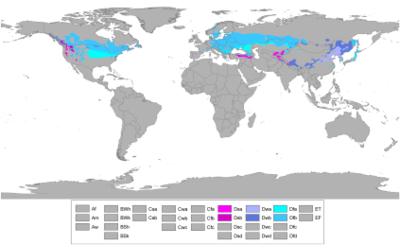Humid continental climate

A humid continental climate is a climatic region defined by Russo-German climatologist Wladimir Köppen in 1900.[1] A place with a humid continental climate has big seasonal temperature differences. It has warm to hot (and often humid) summers and cold (sometimes very cold in the northern areas) winters. Precipitation usually happens throughout the year. In a humid continental climate, the average temperature of the coldest month must be below −3 °C (26.6 °F) [2](or 0 °C (32.0 °F)[3]) and there must be at least four months whose average temperatures are at or above 10 °C (50 °F).
Humid continental climates are usually found between latitudes 40° N and 60° N,[4] within the central and northeastern parts of North America, Europe, and Asia.
References[change | change source]
- ↑ Michal Belda; Eva Holtanová; Tomáš Halenka; Jaroslava Kalvová (2014-02-04). "Climate classification revisited: from Köppen to Trewartha" (PDF). Climate Research. 59 (1): 1–14. Bibcode:2014ClRes..59....1B. doi:10.3354/cr01204.
- ↑ Kottek, Markus; Grieser, Jürgen; Beck, Christoph; Rudolf, Bruno; Rubel, Franz (2006). "World Map of the Köppen-Geiger climate classification updated" (PDF). Meteorologische Zeitschrift. 15 (3): 259–263. Bibcode:2006MetZe..15..259K. doi:10.1127/0941-2948/2006/0130.
- ↑ Peel, M. C.; Finlayson B. L. & McMahon, T. A. (2007). "Updated world map of the Köppen−Geiger climate classification" (PDF). Hydrol. Earth Syst. Sci. 11 (5): 1633–1644. Bibcode:2007HESS...11.1633P. doi:10.5194/hess-11-1633-2007. ISSN 1027-5606. S2CID 9654551.
- ↑ Béla Berényi. Cultivated Plants, Primarily As Food Sources -- Vol II -- Fruit in Northern Latitudes (PDF). Encyclopedia of Life Support Systems. p. 1. Retrieved 2015-02-23.
